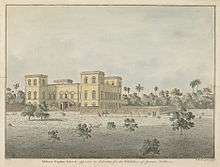William Baillie (artist)
William Baillie (1752/3–Calcutta 1799) was a British artist working in India in the late 18th century.
Life

William Baillie was born in 1752 or 1753.[1] He went to India as a cadet in the Bengal Infantry in 1777, transferred to the Engineers in 1778 and participated in surveying work along the Hooghly River.[2]
He went on leave without pay in 1785 and the next year started a weekly newspaper, the Calcutta Chronicle. He finally resigned from the army in 1788 with the intention of pursuing a career as an artist,[2] but in 1792 he became secretary of the Free School Society in Calcutta[2] and superintendent of the school itself.[3] In the same year he published his "Plan of Calcutta", a reduced version of a map made by Lt. Col. Mark Wood in 1784–5.[4] In 1794 he published a set of hand-coloured aquatints entitled Twelve Views of Calcutta.[1][2] The plates, each measuring 15 by 11 inches, were advertised as "executed in the manner of stained drawings". [5] A further set of eight prints "of the ruins of Gour and Rajmehal" was announced as completed in 1798, but no impressions have been traced.[6]
In a letter of 1795 he told his fellow-artist Ozias Humphry that he had wasted a lot of time painting landscapes, adding that "it is a pleasing pursuit, but not a pot-boiling one."[7] He died in Calcutta in 1799 at the age of 46.[2]
References
- 1 2 "North view of the Water Gate and Royal Barracks Fort William". British Library. Retrieved 9 July 2012.
- 1 2 3 4 5 "South view of Calcutta, taken from the Glacis of Fort William / W. Baillie". Historic Houses Trust. Retrieved 9 July 2012.
- ↑ "HU/4/88-89 William Baillie, Calcutta, to Ozias Humphry, Portrait Painter to His Majesty, No. 13 Old Bond Street, London 23 Nov 1793". Royal Academy Collections. Retrieved 25 May 2016.
- ↑ Chatterjee, Partha, ed. (1995). Texts Of Power:Emerging Disciplines in Colonial Bengal. University of Minnesota Press. p. 165. ISBN 9780816626878.
- ↑ Seton-Carr, W.S., ed. (1865). Selections from Calcutta Gazettes, Volume II. Calcutta: O.T. Cutter. p. 578.
- ↑ "Prints & drawings collection summary". The British Library. Retrieved 25 May 2016.
- ↑ Tillotson, Giles Henry Rupert (2000). The Artificial Empire: The Indian Landscapes of William Hodges. Routledge. p. 121. ISBN 9780700712823.